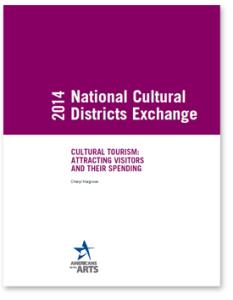
Author: Hargrove, Cheryl
Publication Year: 2014
Media Type: Report
Summary:
Americans for the Arts has commissioned five essays spanning the intricacies of arts, entertainment, and cultural districts specifically for policymakers, arts leaders, planning professionals, community development practitioners, and others who are interested in developing new districts or adapting existing ones.
- Creating Capacity: Strategic Approaches to Managing Arts, Culture, and Entertainment Districts
- Cultural Districts: Bottom-Up and Top-Down Drivers
- Cultural Tourism: Attracting Visitors and Their Spending
- Art and Culture Districts: Financing, Funding, and Sustaining Them
- State Cultural Districts: Metrics, Policies, and Evaluation
These essays and reports are part of our National Cultural Districts Exchange, where you can find more information on cultural district legislation, case studies, a national district survey, and a collection of webinars. www.AmericansForTheArts.org/CulturalDistricts
Abstract:
“Cultural tourism is based on the mosaic of places, traditions, art forms, celebrations, and experiences that define this nation and its people, reflecting the diversity and character of the United States.”
Internationally, the United Nations World Tourism Organization defines cultural tourism based more on visitor intent: “movements of persons for essentially cultural motivations such as study tours, performing arts and cultural tours, travel to festivals and other cultural events, visits to sites and monuments, travel to study nature, folklore or art, and pilgrimages.”
Both of these definitions demonstrate the value and desire of cultural activities as part of a rich, robust, and rewarding visitor experience. Destinations, particularly urban cities, have an opportunity to showcase cultural activities and provide cultural experiences through the formation of cultural districts. Americans for the Arts defines a cultural district as “a well-recognized, labeled, mixed-use area of a settlement in which a high concentration of cultural facilities serves as the anchor of attraction.” These facilities may include performance spaces, museums, galleries, artist studios, arts-related retail shops, music or media produc-tion studios, arts education venues, and/or green space. Cultural districts are traditionally mixed-use developments, integrating both commercial space and residential areas, often designed to revitalize neighborhoods or areas needing economic or societal stimulation. To attract residents, businesses, artists, other members of the creative economies—and indeed, visitors—cultural districts often utilize green space, architecture, and other authen-tic assets to establish a distinctive appearance or authentic “sense of place.”
Focusing more on the opportunities of cultural tourism, cultural districts may combine specific visitor services (boutique hotels, locally sourced restaurants) or include venues (performing arts and convention centers, in particular) as a way to attract key groups to the area. Creating a critical mass of activities available 24/7, the cultural district can be mar-keted as a destination attraction. The availability of cultural districts may tip a convention, a group tour, business meeting, or special event to be hosted in a destination due to the per-ceived (and hopefully real) creative environment. [Introduction p. 3]
Arts & Intersections: Tourism
Categories: Tourism, Cultural Districts
ADDITIONAL BIBLIOGRAPHICAL INFORMATION
PUBLISHER INFORMATION
Name: Americans for the Arts
Website URL: https://www.americansforthearts.org